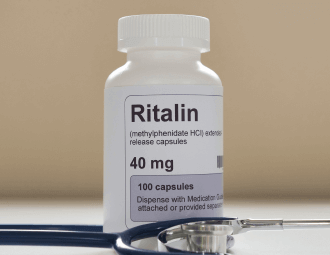AuDHD (pronounced au-D-H-D) is an informal term for having a dual diagnosis of autism spectrum disorder (ASD) and attention deficit hyperactivity disorder (ADHD). Although experts had thought these conditions couldn’t coexist, it’s now recognized that a person can have both. Here’s more about AuDHD, including symptoms, impact, and resources to help you cope.
Highlights
- AuDHD is an informal term commonly used by the neurodivergent community to describe a dual diagnosis of autism and ADHD.
- To be diagnosed, you need to be evaluated for the conditions separately. There’s no single AuDHD test.
- Understanding AuDHD can help reduce misdiagnosis and improve your access to support.
What Is AuDHD?
AuDHD is an insider or informal term used by the neurodivergent community to describe living with autism spectrum disorder (ASD) and attention deficit hyperactivity disorder (ADHD). Although it isn’t officially listed in the DSM-5 (a book of recognized mental health disorders), the term is becoming popular among people in the mental health space as a way to talk about living with these two conditions.
As awareness grows about the possibility of having autism and ADHD together, people are more likely to get evaluated and treated. Research, mental health advocacy organizations, and even social media have helped increase awareness.
Can You Have Both ADHD and Autism?
Yes, you can have ADHD and autism together.
For decades, the cases of having both ADHD and autism weren’t officially recognized by experts. Before 2013, medical guidelines required clinicians to choose between these conditions — even if the symptoms of each were clearly present. This left many people confused, underdiagnosed, misdiagnosed, or struggling to get the full support they needed.
Since 2013, clinicians can diagnose ADHD and autism spectrum disorder together if a person has the symptoms of both. The update also acknowledges the lived experience of many neurodivergent individuals and their families. This shift has improved diagnoses, research, and treatment for
How Common Is AuDHD?
Since AuDHD is an informal term, and awareness is in its infancy, living with both conditions hasn’t been well researched. However, studies suggest co-occurrence is common.
In Children
- About
11.4%[2] of children in the US have ADHD, and about 13% of them also show signs of autism (some studies estimate a higher proportion). - About 2.2% of children in the US have been diagnosed with ASD, and 40–70% of them have signs of ADHD.
Doing the math, this means about 2.5 million children (1.5–3.7%) in the US are living with autism and ADHD.
In Adults
Altogether, the AuDHD community in the US is approximately 8.5 million people.
Evidence suggests ADHD and autism share genetic and neurological underpinnings. Both are neurodevelopmental conditions influenced by differences in brain chemistry, structure, and connectivity.
The rates of both conditions
Still, underdiagnosis is a lingering concern. Some people, especially women and girls with AuDHD, may mask symptoms or present them differently than established clinical descriptions, making it harder to detect. Others may face barriers such as difficulty seeing specialists, long wait times, or cultural differences in symptom interpretation.
Overlapping and Contrasting Traits
People with ADHD and autism have unique challenges because while the conditions have some overlap, they can also contrast sharply. The symptoms can vary from person to person.
Overlapping Symptoms
- Executive Function Difficulties: Trouble with planning, a tendency to procrastinate, disorganization, trouble managing time, and finding it hard to complete tasks on schedule.
- Sensory Sensitivities: Heightened or reduced sensitivity to light, noise, touch, crowds, or taste.
- Social Communication Difficulties: Difficulty reading social cues, maintaining conversations, or navigating group dynamics.
- Emotional Regulation Difficulties: Strong emotional outbursts, trouble calming down, and being easily stressed or burnt out.
Contrasting Traits
- Need for sameness vs. craving novelty: Individuals with ASD often prefer structured, stable, predictable routines, while people with ADHD may seek newness, stimulation, and change.
- Impulsivity vs. preference for routine: ADHD is linked to acting impulsively, while autism often involves a preference for sameness.
- Social drive differences: Many people with ASD may find social interaction draining, whereas people with ADHD may crave connection and be highly social (sometimes in a scattered way).
Autism, ADHD, and AuDHD at a Glance
|
Trait |
Autism |
ADHD |
AuDHD |
|
Executive Function |
Rigid routines help compensate |
Easily distracted, forgetful |
May have both rigidity and distractibility |
|
Sensory Processing |
May be hypersensitive or less sensitive |
Sometimes sensitive |
Sensory overload can worsen attention and regulation |
|
Social Interaction |
May struggle with social cues and limit interaction |
Craves interaction but struggles with boundaries |
Both craves connections and struggles socially |
|
Behavioral Patterns |
Repetitive routines, intense interests |
Impulsivity, novelty-seeking |
Intense interests and impulsivity; may hyperfocus or switch suddenly |
|
Flexibility |
Prefers sameness, resists change |
Seeks change, dislikes monotony |
Torn between a desire for stability and chasing new experiences |
Although some symptoms of ADHD and autism are similar, here are some examples of how the manifestations of these conditions may differ in real-life situations:
- At work: A person with ASD may thrive on clear procedures, while someone with ADHD might struggle with boredom in repetitive tasks. An employee with AuDHD may crave new projects, but needs structure to avoid being overwhelmed.
- In relationships: Someone with ADHD might chat happily in social gatherings, while a person with ASD may avoid crowds and small talk. An individual with AuDHD could go from being highly social to needing long breaks alone.
- At home: A person with ASD may want meals at the same time daily, while someone with ADHD might forget to eat until late at night. Someone with AuDHD might do meal-prep obsessively one week, then abandon the whole idea the next.
What AuDHD Looks Like at Different Life Stages
Living with AuDHD can feel very different depending on your age, responsibilities, environment, and circumstances. People across different age groups may experience considerable difficulties with sensory overload, executive function, and social nuances. Here are some of the ways it can show up, depending on the age.
Children
In this age group, there may be challenges with group play due to difficulty following shifting rules. A child may prefer solitary play with intense focus on specific interests. At school, they may find it hard to sit still, pay attention, or follow lengthy instructions, as well as move from one activity to the next (e.g., recess to class). Conversely, they may excel in areas of deep interest like math, music, chess, or art. Also, sensory overload or frustration may result in emotional outbursts (meltdowns) or withdrawal (shutdowns).

Teens
In adolescence, people with AuDHD learn to hide their traits to fit in socially, which can be exhausting. They may struggle with social cues, leading to isolation, bullying, or feeling “different” from peers.
Dealing with multiple teachers, classes, and assignments can feel overwhelming for them. They may miss deadlines or have incomplete work despite intelligence and effort.
Adults
AuDHD in adults can shape nearly every area of daily life:
- At work, you may struggle with focus in open office environments. You may also have difficulty meeting deadlines or managing competing priorities.
- Hyperfocus can lead to bursts of productivity, but may cause neglect of other tasks.
- Miscommunications or emotional intensity may cause friction in romantic or platonic relationships. You may feel torn between a need for social connection and a need for long periods of spending time alone.
- Chores, budgeting, meal planning, or remembering appointments can create another layer of stress.
- You may experience co-existing mental health concerns like sleep difficulties, anxiety, or depression. Sometimes, this may be due to years of misunderstanding, underdiagnosis, or lack of accommodations. And in some cases, getting diagnosed and treated can reduce symptoms of depression.
Overall, masking, managing sensory sensitivities, and juggling responsibilities can lead to physical and emotional exhaustion.
Read more: Does ADHD Get Worse With Age?

Strengths and Challenges Associated With AuDHD
Strengths
- Strong pattern recognition.
- Deep empathy and honesty.
- Hyperfocus on areas of interest.
- Unique problem-solving approaches.
- Creativity, “thinking outside the box,” and innovation.
Challenges
- Sensory overload in loud, crowded, or bright environments.
- Time blindness (difficulty sensing the passage of time).
- Difficulty with transitions and changes in routine.
- Forgetfulness and disorganization.
- Emotional dysregulation and burnout.
- Other mental health concerns.
AuDHD Diagnosis
There is no single “AuDHD test.” You need to be assessed for ADHD and ASD separately. People who meet the criteria for both conditions are considered to have a dual diagnosis.
The process for getting an ASD or ADHD diagnosis typically includes:
- Clinical interview.
- An overview of developmental history.
- Questionnaires and scales.
- Observation across settings.
- Collateral information from parents, teachers, or close contacts.
Barriers to Diagnosis
Many adults receive their dual diagnosis later in life, which can bring both relief (understanding past struggles) and grief for missed support earlier. It’s not always easy to get diagnosed with AuDHD because you may face
- Masking: As people with AuDHD grow older, they often learn to “mask” their symptoms. Masking means camouflaging traits to appear “neurotypical.” This may involve faking eye contact, suppressing stimming, or hiding any unique interests to fit in. Sometimes, people also say one of the conditions is masking the other, if that one appears more obvious.
- Female/AFAB* presentation differences: Women and girls may be more likely to have internalized symptoms such as anxiety and perfectionism. They may also have better social camouflage.
*AFAB — Assigned female at birth.
AuDHD Support and Treatment Options
Therapy and Behavioral Strategies
Therapy can help you cope with AuDHD. Examples include:
- Cognitive-behavioral therapy (CBT) can help you manage your thoughts and behaviors and create better coping strategies.
- Occupational therapy for executive skills.
- Coaching can help improve social skills and productivity.
Medication
If your healthcare provider thinks you will benefit from medication, you may receive a tailored prescription, which could include:
- Stimulants to reduce ADHD symptoms like inattention and impulsivity.
- Non-stimulants like certain antidepressants or alpha-2 adrenergic agonists, especially if there is also the need to address co-occurring anxiety or depression.
Accommodations
Where possible, it’s a good idea to request accommodation at work and school. These may include:
- School: Individualized educational plans (IEPs) and 504 plans.
- Workplace: Clear communication, flexible hours, and noise reduction may help.
Living With AuDHD: Practical Tips and Strategies
Living successfully with AuDHD often requires a personalized toolkit. You may need to tinker a bit to find the combination of tools, organizational systems, and
- Track tasks and appointments with external reminders like calendars, alarms, sticky notes, or smartphone apps.
- Use sensory regulation tools like noise-canceling headphones, fidget devices, and weighted blankets to reduce overwhelm.
- Break tasks into smaller chunks and try time-blocking to reduce procrastination and decision fatigue.
- Practice mindfulness or relaxation techniques such as deep breathing, guided meditation, or grounding exercises to manage stress.
- Prioritize sleep, exercise, and a healthy diet; studies show this can improve your well-being.
- Seek peer and community support through online groups, local meetups, or neurodivergent-led organizations, which can suggest practical solutions, provide validation, and share strategies.
When to Seek Professional Help
If you have symptoms that suggest ADHD or autism, don’t hesitate to reach for professional support. You may require urgent professional help if:
- Symptoms cause persistent distress, overwhelm, or burnout.
- Daily functioning at work, school, or in relationships is significantly affected.
- Coping strategies are no longer effective, and symptoms seem to worsen over time.
If you’re preparing for an evaluation and wondering how to talk to your doctor, consider bringing:
- A written log of your signs of AuDHD, with examples from different areas of your life. Be as specific as possible, note the time, place, and people involved.
- Records from school or work showing the patterns of difficulty you experience.
- Family or teacher input (this can be especially helpful for children and teens).
AuDHD may be an informal term, but it describes the lived experience of millions. It means straddling two or more worlds. You have to learn to live with ADHD, autism, and neurotypical expectations. Going through an assessment can help you understand your symptoms and get the support you need. Book an appointment with a licensed healthcare provider today to get mental health help online.
FAQs About AuDHD
Is AuDHD a real diagnosis?
Not officially; instead of saying that you have AuDHD, your healthcare provider will say you have both ASD and ADHD. But it is a widely recognized term in the neurodivergent community.
What are the sensory issues with AuDHD?
Sensory issues with AuDHD include hypersensitivity (e.g., to sound, light, or textures) or hyposensitivity (e.g., seeking strong sensory input). These challenges often overlap with ADHD’s distractibility, but they vary from person to person.
How is AuDHD different from ADHD?
ADHD involves challenges with attention, impulsivity, and hyperactivity. AuDHD has those as well as autistic traits such as sensory differences, social communication challenges, and a need for sameness.
How is AuDHD different from autism?
Autism may present with strong focus and routine-loving behaviors, while AuDHD adds ADHD traits like distractibility, impulsivity, or restlessness.
Can ADHD mask autism in adults?
Yes. Some adults develop coping strategies for their autistic traits, and ADHD-related difficulties may overshadow autism signs until later in life.
How do I tell if I'm AuDHD?
You can’t. You may think you do, but only a qualified clinician can diagnose ADHD and autism. However, noticing challenges with attention, sensory processing, and social functioning can be a starting point for seeking an evaluation.
Is AuDHD a disability?
AuDHD can be considered a disability if symptoms significantly interfere with your daily life, but many people with AuDHD see it as a difference that comes with both strengths and challenges.













